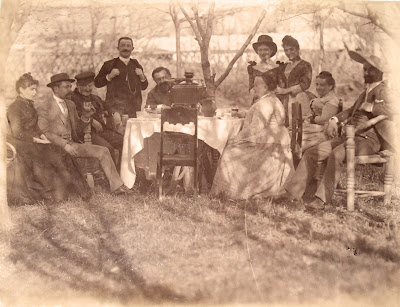 © Family Brocard. Usage of the image under authorization only
© Family Brocard. Usage of the image under authorization onlyCette photo de famille prise dans la propriété Brocard, ancienne demeure du Comte Chérémeteff, rue Nikolskaïa à Moscou, donne une idée de la personnalité d'Henri Brocard.
Autour de la table sont rassemblés différents membres de la famille. De gauche à droite. Marie Ferrand, sérieuse, indifférente, les mains posées sur les genoux. A ses côtés, son époux Auguste Ferrand la main suspendue, est en train de siroter un thé à la russe. L'homme à la casquette assis à ses côtés a un âge certain, les favoris gris et l'oeil amusé par les préparatifs du photographe. Il pourrait s'agir d'Athanase Brocard, père d'Henri ou d'un proche de la famille. Georges Félix Ferrand se trouve être l'homme debout, souriant et sûr de lui les deux mains ancrées sur son gilet.
Assis à l'arrière, presque camouflé par le samovar, se trouve Henri Brocard le parfumeur. Il incline doucement la tête afin d'apparaître sur la photo. Inventeur, créateur de la parfumerie du même nom il est en quelque sorte le patriarche de toute cette communauté. Mais le photographe a choisi de prendre sa photo sans le mettre de façon évidente au centre. C'est une photo de famille dans la simplicité, un peu spontanée, qui souligne la convivialité qui règne dans ce petit groupe, sans trop de formalisme, ou de code de préséance.
Cela laisse deviner quelques traits de caractère d'Henri Brocard. Entrepreneur de grand talent. Aventurier des USA à la Russie. Inventeur créatif de parfums et d'astuces marketing. Découvreur de nouvelles techniques innovantes revendues avec succès à l'entreprise de parfum Roure. Bon vivant si l'on en juge les menus, la qualité des repas de fête et des vins fins les accompagnant, comme son physique généreux.
Doté d'une âme sensible, passionnée, Henri Brocard s'exprime avec profondeur dans le monde des arts et de la bibliophilie. Il s'intéresse avec curiosité à toutes les antiquités, étoffes, oeuvres des primitifs famands, comme aux meubles de la grande époque ou aux porcelaines fines. Il n'est donc pas ce collectionneur exclusif, polarisé sur une thématique, jusqu'à l'obsession... mais celui du collectionneur universel, ayant soif de savoir, enthousiasmé par la découverte et l'objet qui raconte une histoire. En dépit de tout cela il est resté simple, accessible, chaleureux, au point d'être discret si ce n'est cette inclinaison demandée de sa tête pour apparaître tout de même sur cette photographie.
J'aurais tellement aimé le rencontrer...
La famille est large et accueillante. Aux côtés d'Henri se trouve "tante" Mina Koch qui a élevé tous les enfants Brocard. Elle est née en Saxe avant de venir très jeune avec sa famille en Russie à Arkpangel, avant les années 20 et l'arrivée du chemin de fer dans ces contrés vers 1827. Elle est décédée à Moscou en 1897. Elle est assise à la table comme un membre d'adoption de la famille, devant Charlotte Brocard, épouse d'Henri qui se trouve juste derrière.
Les deux jeunes femmes sur la droite sont Eugénie Ferrand, fille d'Henri Brocard et Isabelle Giraud. Cette dernière porte un chapeau d'homme sans doute échangé avec son mari situé tout à droite de la photographie. Le sourire dessiné sur les lèvres d'Isabelle, comme le geste d'affection d'Eugénie qui lui tient le bras, soulignent les liens privilégiés de cette grande famille française dans la ville de Moscou.
La chaise vide au centre montre de façon explicite que le photographe, grand absent de cette scène est bien probablement un membre de la famille. Sans doute Emile Brocard un des plus jeunes à cette époque.
J'aime également beaucoup dans cette photo, les ombres des branchages. Elles tissent comme les liens involontaires d'un arbre généalogique entre tous les membres rassemblés autour de ce moment de partage lors du thé.

 Une belle vue de l'usine Brocard, 14 ans après la disparition d'Henri Brocard. Ses enfants ont repris les rênes de l'affaire. Nous sommes en 1914. Son fils Alexandre et sa fille Eugénie, mon arrière-arrière grand mère, gèrent avec maestro les destinés de l'entreprise. L'entreprise assez considérable exporte dans une grande partie du monde. Plus de 14 millions de flaçons en verre sont nécessaires pour le packaging des différentes essences.
Une belle vue de l'usine Brocard, 14 ans après la disparition d'Henri Brocard. Ses enfants ont repris les rênes de l'affaire. Nous sommes en 1914. Son fils Alexandre et sa fille Eugénie, mon arrière-arrière grand mère, gèrent avec maestro les destinés de l'entreprise. L'entreprise assez considérable exporte dans une grande partie du monde. Plus de 14 millions de flaçons en verre sont nécessaires pour le packaging des différentes essences.
 Une vue imprimée de la galerie où se trouvait la collection de tableaux anciens et antiquités d'Henri Brocard, qui fut ensuite reprise par son épouse Charlotte.
Une vue imprimée de la galerie où se trouvait la collection de tableaux anciens et antiquités d'Henri Brocard, qui fut ensuite reprise par son épouse Charlotte.

 Nous avons quelques photos posées d'Henri Brocard mais très peu dans son laboratoire ou son intérieur.
Nous avons quelques photos posées d'Henri Brocard mais très peu dans son laboratoire ou son intérieur.
